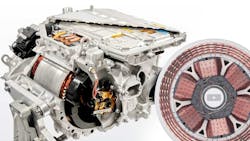New Motor Designs Help EV Makers Kick the Rare-Earth Habit (Part 1) (Download)
At present, roughly 90% of the electric vehicles on the road are powered by permanent-magnet synchronous motors (PMSMs). All PMSMs rely on significant amounts of so-called rare-earth (RE) minerals to make them compact, practical, and powerful enough to compete with internal combustion engines. Although the unique properties of REs such as neodymium, terbium, and dysprosium have played an important role in the success of EVs, there’s a growing trend within the industry to reduce their use or eliminate them entirely.
The shift is being motivated in part by the rising costs of RE materials,1 but many manufacturers are also acutely aware of the environmental impacts associated with mining and refining them.2 Furthermore, European and North American manufacturers are concerned about the geopolitical impact of their dependence on REs that, at least for now, are primarily sourced from China, Africa, and other sensitive parts of the world.3
